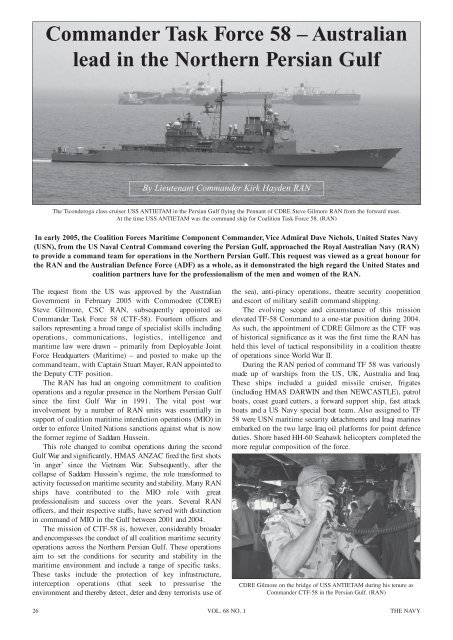The Navy Vol_68_No_1 Jan 2006 - Navy League of Australia
The Navy Vol_68_No_1 Jan 2006 - Navy League of Australia
The Navy Vol_68_No_1 Jan 2006 - Navy League of Australia
You also want an ePaper? Increase the reach of your titles
YUMPU automatically turns print PDFs into web optimized ePapers that Google loves.
Commander Task Force 58 – <strong>Australia</strong>n<br />
lead in the <strong>No</strong>rthern Persian Gulf<br />
By Lieutenant Commander Kirk Hayden RAN<br />
<strong>The</strong> Ticonderoga class cruiser USS ANTIETAM in the Persian Gulf flying the Pennant <strong>of</strong> CDRE Steve Gilmore RAN from the forward mast.<br />
At the time USS ANTIETAM was the command ship for Coalition Task Force 58. (RAN)<br />
In early 2005, the Coalition Forces Maritime Component Commander, Vice Admiral Dave Nichols, United States <strong>Navy</strong><br />
(USN), from the US Naval Central Command covering the Persian Gulf, approached the Royal <strong>Australia</strong>n <strong>Navy</strong> (RAN)<br />
to provide a command team for operations in the <strong>No</strong>rthern Persian Gulf. This request was viewed as a great honour for<br />
the RAN and the <strong>Australia</strong>n Defence Force (ADF) as a whole, as it demonstrated the high regard the United States and<br />
coalition partners have for the pr<strong>of</strong>essionalism <strong>of</strong> the men and women <strong>of</strong> the RAN.<br />
<strong>The</strong> request from the US was approved by the <strong>Australia</strong>n<br />
Government in February 2005 with Commodore (CDRE)<br />
Steve Gilmore, CSC RAN, subsequently appointed as<br />
Commander Task Force 58 (CTF-58). Fourteen <strong>of</strong>ficers and<br />
sailors representing a broad range <strong>of</strong> specialist skills including<br />
operations, communications, logistics, intelligence and<br />
maritime law were drawn – primarily from Deployable Joint<br />
Force Headquarters (Maritime) – and posted to make up the<br />
command team, with Captain Stuart Mayer, RAN appointed to<br />
the Deputy CTF position.<br />
<strong>The</strong> RAN has had an ongoing commitment to coalition<br />
operations and a regular presence in the <strong>No</strong>rthern Persian Gulf<br />
since the first Gulf War in 1991. <strong>The</strong> vital post war<br />
involvement by a number <strong>of</strong> RAN units was essentially in<br />
support <strong>of</strong> coalition maritime interdiction operations (MIO) in<br />
order to enforce United Nations sanctions against what is now<br />
the former regime <strong>of</strong> Saddam Hussein.<br />
This role changed to combat operations during the second<br />
Gulf War and significantly, HMAS ANZAC fired the first shots<br />
‘in anger’ since the Vietnam War. Subsequently, after the<br />
collapse <strong>of</strong> Saddam Hussein’s regime, the role transformed to<br />
activity focussed on maritime security and stability. Many RAN<br />
ships have contributed to the MIO role with great<br />
pr<strong>of</strong>essionalism and success over the years. Several RAN<br />
<strong>of</strong>ficers, and their respective staffs, have served with distinction<br />
in command <strong>of</strong> MIO in the Gulf between 2001 and 2004.<br />
<strong>The</strong> mission <strong>of</strong> CTF-58 is, however, considerably broader<br />
and encompasses the conduct <strong>of</strong> all coalition maritime security<br />
operations across the <strong>No</strong>rthern Persian Gulf. <strong>The</strong>se operations<br />
aim to set the conditions for security and stability in the<br />
maritime environment and include a range <strong>of</strong> specific tasks.<br />
<strong>The</strong>se tasks include the protection <strong>of</strong> key infrastructure,<br />
interception operations (that seek to pressurise the<br />
environment and thereby detect, deter and deny terrorists use <strong>of</strong><br />
the sea), anti-piracy operations, theatre security cooperation<br />
and escort <strong>of</strong> military sealift command shipping.<br />
<strong>The</strong> evolving scope and circumstance <strong>of</strong> this mission<br />
elevated TF-58 Command to a one-star position during 2004.<br />
As such, the appointment <strong>of</strong> CDRE Gilmore as the CTF was<br />
<strong>of</strong> historical significance as it was the first time the RAN has<br />
held this level <strong>of</strong> tactical responsibility in a coalition theatre<br />
<strong>of</strong> operations since World War II.<br />
During the RAN period <strong>of</strong> command TF 58 was variously<br />
made up <strong>of</strong> warships from the US, UK, <strong>Australia</strong> and Iraq.<br />
<strong>The</strong>se ships included a guided missile cruiser, frigates<br />
(including HMAS DARWIN and then NEWCASTLE), patrol<br />
boats, coast guard cutters, a forward support ship, fast attack<br />
boats and a US <strong>Navy</strong> special boat team. Also assigned to TF<br />
58 were USN maritime security detachments and Iraqi marines<br />
embarked on the two large Iraq oil platforms for point defence<br />
duties. Shore based HH-60 Seahawk helicopters completed the<br />
more regular composition <strong>of</strong> the force.<br />
CDRE Gilmore on the bridge <strong>of</strong> USS ANTIETAM during his tenure as<br />
Commander CTF-58 in the Persian Gulf. (RAN)<br />
26 VOL. <strong>68</strong> NO. 1 THE NAVY

















